*NURSING > TEST BANK > Test Bank: Maternal-Newborn Nursing: The Critical Components of Nursing Care, 3rd Edition, Roberta D (All)
Test Bank: Maternal-Newborn Nursing: The Critical Components of Nursing Care, 3rd Edition, Roberta Durham, Linda Chapman
Document Content and Description Below
Test Bank: Maternal-Newborn Nursing: The Critical Components of Nursing Care, 3rd Edition, Roberta Durham, Linda Chapman| Comprehensive Coverage of Topics| Download for Grade A+| Chapter 1: Trends an... d Issues Chapter 2: Ethics and Standards of Practice Issues Chapter 3: Genetics, Conception, Fetal Development, and Reproductive Technology Chapter 4: Physiological Aspects of AntepartumCare (FREE) Chapter 5: Psycho-Social-Cultural Aspects of the Antepartum Period Chapter 6:Antepartal Tests Chapter 7: High-Risk Antepartum Nursing Care Chapter 8: Intrapartum Assessment and Interventions Chapter 9: Fetal Heart Rate Assessment Chapter 10: High-Risk Labor and Birth Chapter 11: Intrapartum and Postpartum Care of Cesarean Birth Families Chapter 12 Postpartum Physiological Assessments and Nursing Care Chapter 15: Physiological and Behavioral Responses of the Neonate Chapter 16: Discharge Planning and Teaching Chapter 17: High-Risk Neonatal Nursing Care Chapter 1: Trends and Issues MULTIPLE CHOICE 1. The nurse is caring for a patient who is in labor with her first child. The patient’s mother is present for support and notes that things have changed in the delivery room since she last gave birth in the early 1980s. Which current trend or intervention may the patient’s mother find most different? 1. Fetal monitoring throughout labor 2. Postpartum stay of 10 days 3. Expectant partner and family in operating room for cesarean birth 4. Hospital support for breastfeeding ANS: 4 Chapter: Chapter 1 Trends and Issues Chapter Learning Objective: 1. Discuss current trends in the management of labor and birth Page: 4 Heading: Table 1-1: Past and Present Trends Integrated Processes: Nursing Process Client Need: Health Promotion and Maintenance Cognitive Level: Application [Applying] Concept: Evidence-Based Practice Difficulty: Moderate Feedback 1 This is incorrect. Fetal monitoring during labor began in the late 1970s. As such, this likely would have occurred during the mother’s labor and delivery during the 1980s. 2 This is incorrect. In the past, the average hospital postpartum stay was 10 days. Presently, the average postpartum stay is 48 hours or less. 3 This is incorrect. In the past, expectant partners and families were excluded from the labor and birth experience. Present trends involve the expectant partner and family in the labor and birth experience, including presence in the operating room for cesarean births. 4 This is correct. Hospital support for breastfeeding, including a lactation consultant and employment of the Baby-Friendly Hospital Initiative, were both enacted during the early 1990s. PTS: 1 CON: Evidence-Based Practice 2. A patient with a history of hypertension is giving birth. During delivery, the staff was not able to stabilize the patient’s blood pressure. As a result, the patient died shortly after delivery. This is an example of what type of death? 1. Early maternal death 2. Late maternal death 3. Direct obstetric death 4. Indirect obstetric death ANS: 4 Chapter: Chapter 1 Trends and Issues Chapter Learning Objective: 2. Discuss current trends in maternal and infant health outcomes. Page: 7 Heading: Trends > Maternal Death and Mortality Rates Integrated Processes: Nursing Process Client Need: Physiological Integrity: Reduction of Risk Potential Cognitive Level: Application [Applying] Concept: Ante/Intra/Post-partum Difficulty: Hard Feedback 1 This is incorrect. Early maternal death is not an example of maternal death. Examples of maternal death include late maternal death, indirect obstetric death, direct obstetric death, and pregnancy-related death. 2 This is incorrect. Late maternal death occurs 42 days after termination of pregnancy from a direct or indirect obstetric cause. 3 This is incorrect. Direct obstetric death results from complications during pregnancy, labor, birth, and/or postpartum period. 4 This is correct. Indirect obstetric death is caused by a preexisting disease, or a disease that develops during pregnancy. PTS: 1 CON: Ante/Intra/Post-partum 3. The nurse is providing education to a patient who has given birth to her first child and is being discharged home. The patient expressed concern regarding infant mortality and sudden infant death syndrome (SIDS). The patient had an uncomplicated pregnancy, labor, and vaginal delivery. She has a body mass index of 25 and has no other health conditions. The infant is healthy and was delivered full-term. What will be most helpful thing to explain to the patient? 1. Uses of extracorporeal membrane oxygenation therapy (ECMO) 2. Uses of exogenous pulmonary surfactant 3. The Baby-Friendly Hospital Initiative 4. The Safe to Sleep campaign ANS: 4 Chapter: Chapter 1 Trends and Issues Chapter Learning Objective: 3. Identify leading causes of infant death. Page: 7 Heading: Trends > Infant Mortality Rates Integrated Processes: Nursing process Client Need: Safe and Effective Care Environment: Safety and Infection Control Cognitive Level: Application [Applying] Concept: Health Promotion Difficulty: Moderate Feedback 1 This is incorrect. EMCO has been cited as one of the factors that has reduced infant mortality among preterm infants. 2 This is incorrect. Although advances in medical treatments have decreased infant mortality, exogenous pulmonary surfactant is primarily used to reduce mortality of preterm infants. 3 This is incorrect. The Baby-Friendly Hospital Initiative was developed to support breastfeeding and is not directly linked to reduced infant mortality or SIDS. 4 This is correct. The Back to Sleep campaign and the Safe to Sleep campaigns were designed to promote healthy infant sleeping habits. The decrease in SIDS from 1995 to 2015 was attributed to the Safe to Sleep campaign. PTS: 1 CON: Health Promotion 4. The nurse is caring for a 14-year-old patient who is 32 weeks pregnant. After complaining of genital sores and discomfort, the patient tests positive for syphilis. The fetus is at increased risk of which condition? 1. Diabetes 2. Blindness 3. Pneumonia 4. Hypertension ANS: 4 Chapter: Chapter 1 Trends and Issues Chapter Learning Objective: 4. Discuss current maternal and infant health issues. Page: 10 Heading: Issues > Teen Pregnancy > Implications of Teen Pregnancy and Birth Integrated Processes: Nursing Process Client Need: Physiological Integrity: Reduction of Risk Potential Cognitive Level: Application [Applying] Concept: Ante/Intra/Post-partum Difficulty: Moderate Feedback 1 This is incorrect. Maternal obesity increases a child’s risk of developing childhood obesity and diabetes. 2 This is correct. Neonatal blindness, maternal death, and neonatal death are all associated with a patient who contracts syphilis during pregnancy. 3 This is incorrect. Chlamydial pneumonia is associated with maternal chlamydia. 4 This is incorrect. Teen mothers may have a higher risk of contracting sexually transmitted illnesses and hypertension during pregnancy; however, maternal syphilis is not associated with fetal hypertension. PTS: 1 CON: Ante/Intra/Post-partum 5. The nurse is caring for a 15-year-old female who is pregnant with her first child. In her previous prenatal visit, the patient tested negative for chlamydia, syphilis, gonorrhea, and HIV. Based on the information provided, which condition is the patient’s baby at higher risk for? 1. Intestinal problems 2. Neonatal conjunctivitis 3. Blindness 4. Pneumonia ANS: 1 Chapter: Chapter 1 Trends and Issues Chapter Learning Objective: 4. Discuss current maternal and infant health issues. Page: 11 Heading: Issues > Teen Pregnancy Integrated Processes: Nursing Process Client Need: Physiological Integrity: Reduction of Risk Potential Cognitive Level: Application [Applying] Concept: Health Promotion Difficulty: Difficult Feedback 1 This is correct. Infants born to teen mothers are at increased risk for various conditions related to prematurity, including infant death, intestinal problems, and/or respiratory distress syndrome. 2 This is incorrect. Infants born to teen mothers who have gonorrhea are at increased risk of neonatal conjunctivitis and blindness. 3 This is incorrect. Infants born to teen mothers with syphilis and gonorrhea are at increased risk of blindness. 4 This is incorrect. Infants born to teen mothers with chlamydia may be at increased risk of developing chlamydial pneumonia. PTS: 1 CON: Health Promotion 6. The nurse is caring for a 23-year-old patient who arrives at the clinic for a pregnancy test. The test confirms the patient is pregnant. The patient states, ―I do not need to stop smoking my electronic cigarette because it will not harm my baby.‖ Which is the best response by the nurse? 1. ―You are correct. Electronic cigarettes are not harmful during pregnancy.‖ 2. ―Tobacco products, including electronic cigarettes, should not be used during pregnancy due to risking nicotine toxicity.‖ 3. ―According to the FDA, although electronic cigarettes are safe for you, they can cause harm to the fetus during pregnancy.‖ 4. ―Electronic cigarettes are considered harmful only in the first trimester.‖ ANS: 2 Chapter: Chapter 1 Trends and Issues Chapter Learning Objective: 4. Discuss current maternal and infant health issues. Page: 12 Heading: Issues > Tobacco and Electronic Cigarette Use During Pregnancy Integrated Processes: Nursing Process Client Need: Safe and Effective Care Environment: Safety and Infection Control Cognitive Level: Application [Applying] Concept: Ante/Intra/Post-partum Difficulty: Moderate Feedback 1 This is incorrect. Electronic cigarettes can be harmful during pregnancy. 2 This is correct. Pregnant women should not use tobacco products or electronic cigarettes during pregnancy. 3 This is incorrect. Electronic cigarettes are not controlled by the FDA and may be harmful to both mother and fetus. 4 This is incorrect. Electronic cigarettes are considered harmful during pregnancy. PTS: 1 CON: Ante/Intra/Post-partum 7. The nurse is caring for a 16-year-old patient who is 32 weeks pregnant with her first child, who is male. The patient’s mother has accompanied her to today’s visit. During the nursing assessment, the patient mentions that she is no longer in a relationship with the baby’s father but her mother plans to help her. However, the patient’s mother asks whether this will have any impact on the child. Which should the nurse indicate the child is at increased risk of during his adolescence? 1. Hypertension 2. Diabetes 3. Alcohol abuse 4. Intraventricular bleeding ANS: 3 Chapter: Chapter 1 Trends and Issues Chapter Learning Objective: 4. Discuss current maternal and infant health issues. Page: 12 Heading: Issues > Teen Pregnancy > Implications of Teen Pregnancy and Birth Integrated Processes: Nursing Process Client Need: Physiological Integrity: Reduction of Risk Potential Cognitive Level: Application [Applying] Concept: Ante/Intra/Post-partum Difficulty: Moderate Feedback 1 This is incorrect. Teen mothers, rather than their children, are at increased risked of hypertension during pregnancy. 2 This is incorrect. Children born to mothers who are obese have an increased risk of developing childhood obesity and childhood diabetes. 3 This is correct. Statistics have shown that adolescent boys without an involved father may be at higher risk of incarceration, dropping out of school, and abusing drugs or alcohol. 4 This is incorrect. Children born to teen mothers are at increased risk for health problems associated with low birth weight, including intraventricular bleeding. PTS: 1 CON: Ante/Intra/Post-partum 8. The nurse is caring for a patient at 7 weeks gestation. The nurse suspects that a pregnant patient may have been using marijuana. With consent, the nurse confirms via urine drug screen. Which statement by the nurse is most appropriate? 1. ―Did you smoke marijuana when pregnant with your other child?‖ 2. ―To avoid negative effects on your baby, you’ll need to stop using marijuana during your last trimester.‖ 3. ―Using marijuana while pregnant can have a negative effect on the neurological development of your baby.‖ 4. ―Marijuana use while pregnant greatly increases your risk of miscarriage.‖ ANS: 3 Chapter: Chapter 1 Trends and Issues Chapter Learning Objective: 3. Identify leading causes of infant death. Page: 13 Heading: Issues > Substance Abuse During Pregnancy Integrated Processes: Nursing Process Client Need: Safe and Effective Care Environment: Safety and Infection Control Cognitive Level: Application [Applying] Concept: Ante/Intra/Post-partum Difficulty: Moderate Feedback 1 This is incorrect. Whether or not the woman used marijuana during her previous pregnancy is not relevant to her current care. 2 This is incorrect. Marijuana should not be used at any point during pregnancy. 3 This is correct. Marijuana use during pregnancy may have a negative effect on the neurological development of the fetus. 4 This is incorrect. There currently is no research linking marijuana use to increased risk of miscarriage. PTS: 1 CON: Ante/Intra/Post-partum 9. The nurse is counseling a female patient about alcohol use during pregnancy. Which statement by the patient demonstrates successful patient teaching? 1. ―I will limit my drinking to just one alcoholic beverage per day.‖ 2. ―It’s best for my baby if I avoid drinking during pregnancy.‖ 3. ―An occasional drink on special occasions is okay.‖ 4. ―Drinking alcohol is only acceptable in the first trimester.‖ ANS: 2 Chapter: Chapter 1 Trends and Issues Chapter Learning Objective: 3. Identify leading causes of infant death. Page: 13 Heading: Issues > Substance Abuse During Pregnancy Integrated Processes: Nursing Process Client Need: Safe and Effective Care Environment: Safety and Infection Control Cognitive Level: Application [Applying] Concept: Ante/Intra/Post-partum Difficulty: Moderate Feedback 1 This is incorrect. Alcohol should not be consumed while pregnant. 2 This is correct. Drinking alcohol while pregnant can cause low birth weight, fetal alcohol syndrome, mental retardation, and intrauterine growth restriction. 3 This is incorrect. Alcohol should not be consumed while pregnant. 4 This is incorrect. Alcohol should not be consumed while pregnant. PTS: 1 CON: Ante/Intra/Post-partum 10. The nurse is educating the pregnant patient with a body mass index (BMI) of 33. The nurse knows that teaching has been effective when the patient states which of the following? 1. ―My child may be at increased risk for birth injury.‖ 2. ―My child may have a decreased risk of developing childhood diabetes.‖ 3. ―I will probably give birth vaginally.‖ 4. ―I have a lower risk of developing gestational hypertension.‖ ANS: 1 Chapter: Chapter 1 Trends and Issues Chapter Learning Objective: 4. Discuss current maternal and infant health issues. Page: 13 Heading: Issues > Obesity Integrated Processes: Nursing Process Client Need: Safe and Effective Care Environment: Safety and Infection Control Cognitive Level: Application [Applying] Concept: Ante/Intra/Post-partum Difficulty: Difficult Feedback 1 This is correct. Shoulder dystocia and other birth injuries are associated with infant macrosomia (large size) due to maternal obesity. 2 This is incorrect. Children born to mothers who are obese are at increased risk of developing childhood obesity and diabetes. 3 This is incorrect. Pregnant patients who are obese are at increased risk of cesarean birth. 4 This is incorrect. Pregnant patients who are obese have an increased risk of developing gestational diabetes and gestational hypertension. PTS: 1 CON: Ante/Intra/Post-partum 11. A pregnant woman weighs 90.9 kg. The nurse is educating the patient on complications that the patient may be at risk for during pregnancy. Which response by the patient indicates that she understands? 1. ―Due to my weight, there is a possibility that I may develop gestational diabetes.‖ 2. ―I am not overweight, but I am still at risk for gestational diabetes.‖ 3. ―My mother had preeclampsia during one of her pregnancies.‖ 4. ―I will need to do a glucose tolerance test in my second trimester.‖ ANS: 1 Chapter: Chapter 1 Trends and Issues Chapter Learning Objective: 4. Discuss current maternal and infant health issues. Page: 13 Heading: Issues > Obesity Integrated Processes: Nursing Process Client Need: Safe and Effective Care Environment: Management of Care Cognitive Level: Application [Applying] Concept: Ante/Intra/Post-partum Difficulty: Difficult Feedback 1 This is correct. The patient is at risk for gestational diabetes due to being obese during pregnancy. 2 This is incorrect. The patient is overweight. 3 This is incorrect. This response is not related to the question. 4 This is incorrect. The patient will need to get the glucose tolerance test in the second trimester, but this response does not relate to the question. PTS: 1 CON: Ante/Intra/Post-partum 12. The nurse is taking a history of a mother who admits to cocaine drug use. Which action should the nurse take first? 1. Refer the patient to a drug abuse program. 2. Screen the infant for side effects associated with cocaine use. 3. Educate the patient of the risks associated with cocaine use during pregnancy. 4. Advise the patient that her baby will be okay even with the history of cocaine use. ANS: 3 Chapter: Chapter 1 Trends and Issues Chapter Learning Objective: 3. Identify leading causes of infant death. Page: 13 Heading: Issues > Substance Abuse During Pregnancy Integrated Processes: Nursing Process Client Need: Safe and Effective Care Environment: Safety and Infection Control Cognitive Level: Application [Applying] Concept: Ante/Intra/Post-partum Difficulty: Difficult Feedback 1 This is incorrect. This is appropriate, but not the first action the nurse should take. 2 This is incorrect. The infant is not screened for side effects of maternal drug use until delivery. 3 This is correct. The patient should be educated on possible risks associated with drug use. 4 This is incorrect. It is not appropriate to tell a patient ―your baby will be okay‖ in any circumstance. PTS: 1 CON: Ante/Intra/Post-partum 13. A pregnant patient with a BMI of 35 is concerned about health effects she and her baby may face during pregnancy. During routine testing, the patient tested negative for sexually transmitted illnesses (STIs) and indicated that she is in a committed, long-term relationship with the child’s father. Which of the following is accurate? 1. The patient’s infant is at increased risk of neonatal blindness. 2. The patient’s infant has a decreased risk of birth injury. 3. The patient will have increased risk of wound infection. 4. The patient will have a decreased risk of preeclampsia. ANS: 3 Chapter: Chapter 1 Trends and Issues Chapter Learning Objective: 4. Discuss current maternal and infant health issues. Page: 14 Heading: Issues > Obesity Integrated Processes: Nursing Process Client Need: Physiological Integrity: Reduction of Risk Potential Cognitive Level: Application [Applying] Concept: Ante/Intra/Post-partum Difficulty: Difficult Feedback 1 This is incorrect. Infants born to mothers with certain sexually transmitted illnesses (STIs) are at increased risk of neonatal blindness. 2 This is incorrect. Infants born to obese pregnant women have increased risk of birth injury related to macrosomia. 3 This is correct. Obese pregnant patients are at increased risk for wound infections. 4 This is incorrect. Obese pregnant patients have an increased risk of developing certain conditions, including gestational diabetes, gestational hypertension, and preeclampsia. PTS: 1 CON: Ante/Intra/Post-partum 14. The nurse has made it a goal to increase the rate at which women begin prenatal care in the first trimester. The nurse relates this decision to national goals for better maternal and infant outcomes. What guidelines will the nurse use to guide her maternal health goals? 1. WHO Maternal care guidelines 2. State Practice Acts 3. AWHONN white papers 4. Healthy People 2020 ANS: 4 Chapter: Chapter 1 Trends and Issues Chapter Learning Objective: 5. Identify the primary maternal and infant goals of Healthy People 2020. Page: 15 Heading: Maternal and Child Health Goals Integrated Processes: Nursing Process Client Need: Health Promotion and Maintenance Cognitive Level: Application [Applying] Concept: Health Promotion Difficulty: Moderate Feedback 1 This is incorrect. The WHO guidelines are too broad for this purpose, and the nurse will need to use national goals. 2 This is incorrect. State practice acts specify legal requirements rather than health promotion goals. 3 This is incorrect. AWHONN white papers will present positions but not necessarily detail health promotion goals. 4 This is correct. The national goals for improving maternal and infant health are found in Healthy People 2020. PTS: 1 CON: Health Promotion 15. A nursing student is asked to set goals that will decrease the fetal death outcomes during delivery. What guidelines will the nursing student use to assist in setting her goals? 1. WHO Maternal care guidelines 2. Healthy People 2020 3. AWHONN white papers 4. State Practice Act ANS: 2 Chapter: Chapter 1 Trends and Issues Chapter Learning Objective: 5. Identify the primary maternal and infant goals of Healthy People 2020. Page: 15 Heading: Maternal and Child Health Goals Integrated Processes: Nursing Process Client Need: Health Promotion and Maintenance Cognitive Level: Application [Applying] Concept: Health Promotion Difficulty: Moderate Feedback 1 This is incorrect. The WHO guidelines are too broad for this purpose and the nurse will need to use national goals. 2 This is correct. The national goals for improving maternal and infant health are found in Healthy People 2020. 3 This is incorrect. AWHONN white papers will present positions but not necessarily detail health promotion goals. 4 This is incorrect. State practice acts specify legal requirements rather than health promotion goals. PTS: 1 CON: Health Promotion [Show More]
Last updated: 11 months ago
Preview 1 out of 292 pages

Also available in bundle (1)

NURSING TEST BANKS BUNDLE
NURSING TEST BANKS BUNDLE
By Quiz Merchant 2 years ago
$700.5
102
Reviews( 0 )
Recommended For You
*NURSING> TEST BANK > Test Bank for Maternal-Newborn Nursing The Critical Components of Nursing Care 3rd Edition Durham Chapman All Chapters (All)
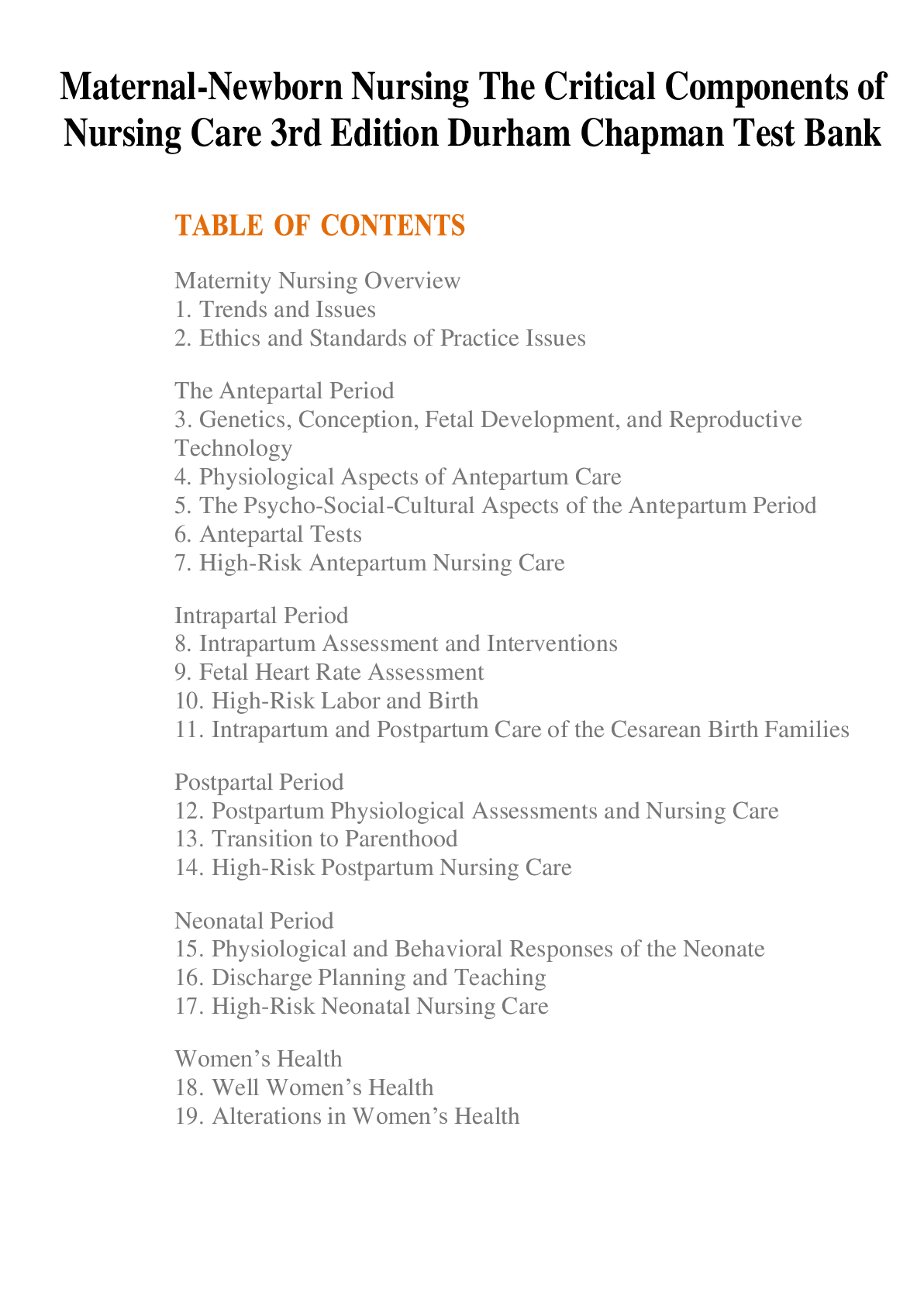
Test Bank for Maternal-Newborn Nursing The Critical Components of Nursing Care 3rd Edition Durham Chapman All Chapters
Test Bank for Maternal-Newborn Nursing The Critical Components of Nursing Care 3rd Edition Durham Chapman All Chapters Test Bank for Maternal-Newborn Nursing The Critical Components of Nursing Care 3r...
By Gradexam , Uploaded: Mar 12, 2024
$20
*NURSING> TEST BANK > Test Bank for Pediatric Nursing The Critical Components of Nursing Care 2nd Edition Rudd All Chapters (All)
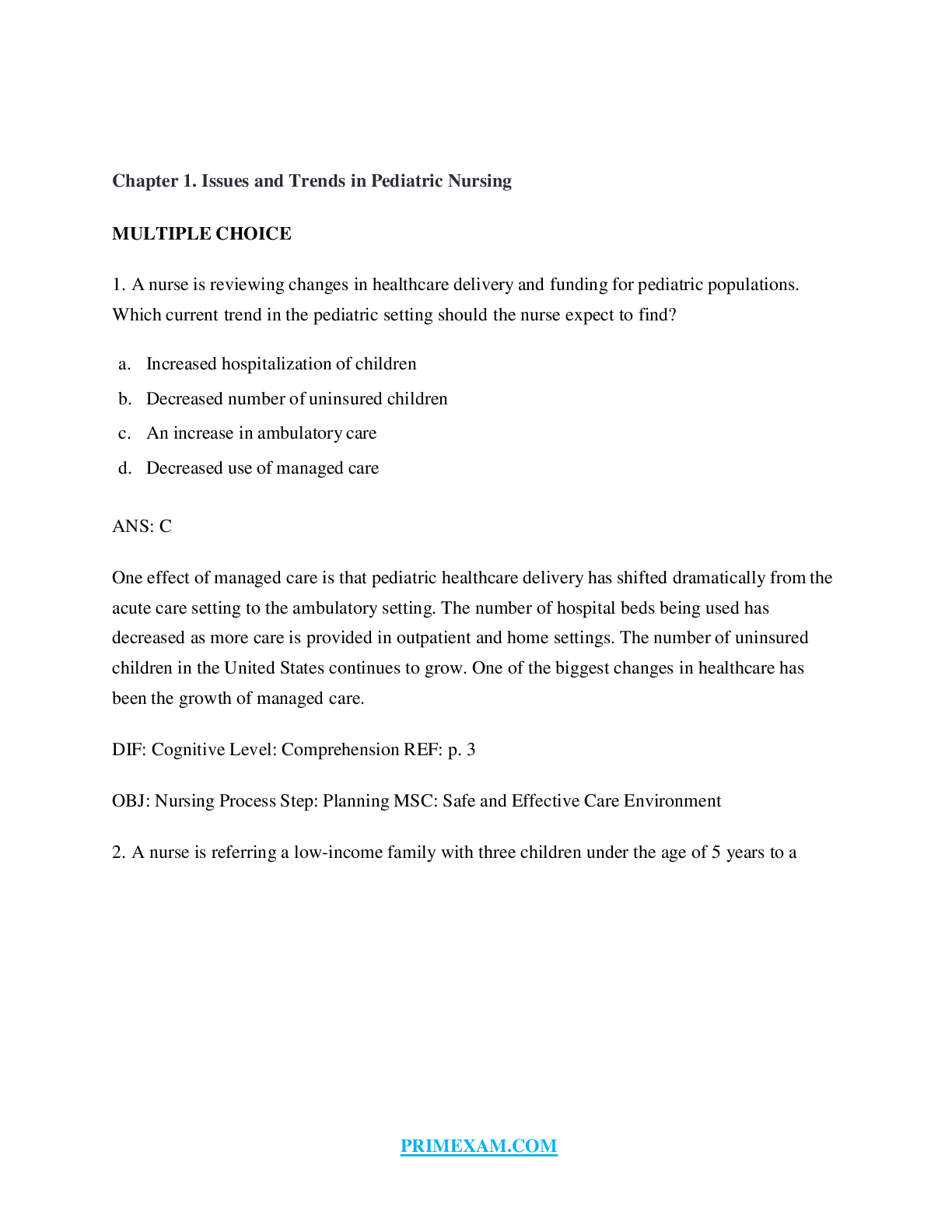
Test Bank for Pediatric Nursing The Critical Components of Nursing Care 2nd Edition Rudd All Chapters
Test Bank for Pediatric Nursing The Critical Components of Nursing Care 2nd Edition Rudd All ChaptersTest Bank for Pediatric Nursing The Critical Components of Nursing Care 2nd Edition Rudd All Chapte...
By Gradexam , Uploaded: Mar 13, 2024
$20
*NURSING> TEST BANK > Pediatric Nursing The Critical Components of Nursing Care 2nd Edition Rudd Test Bank (All)
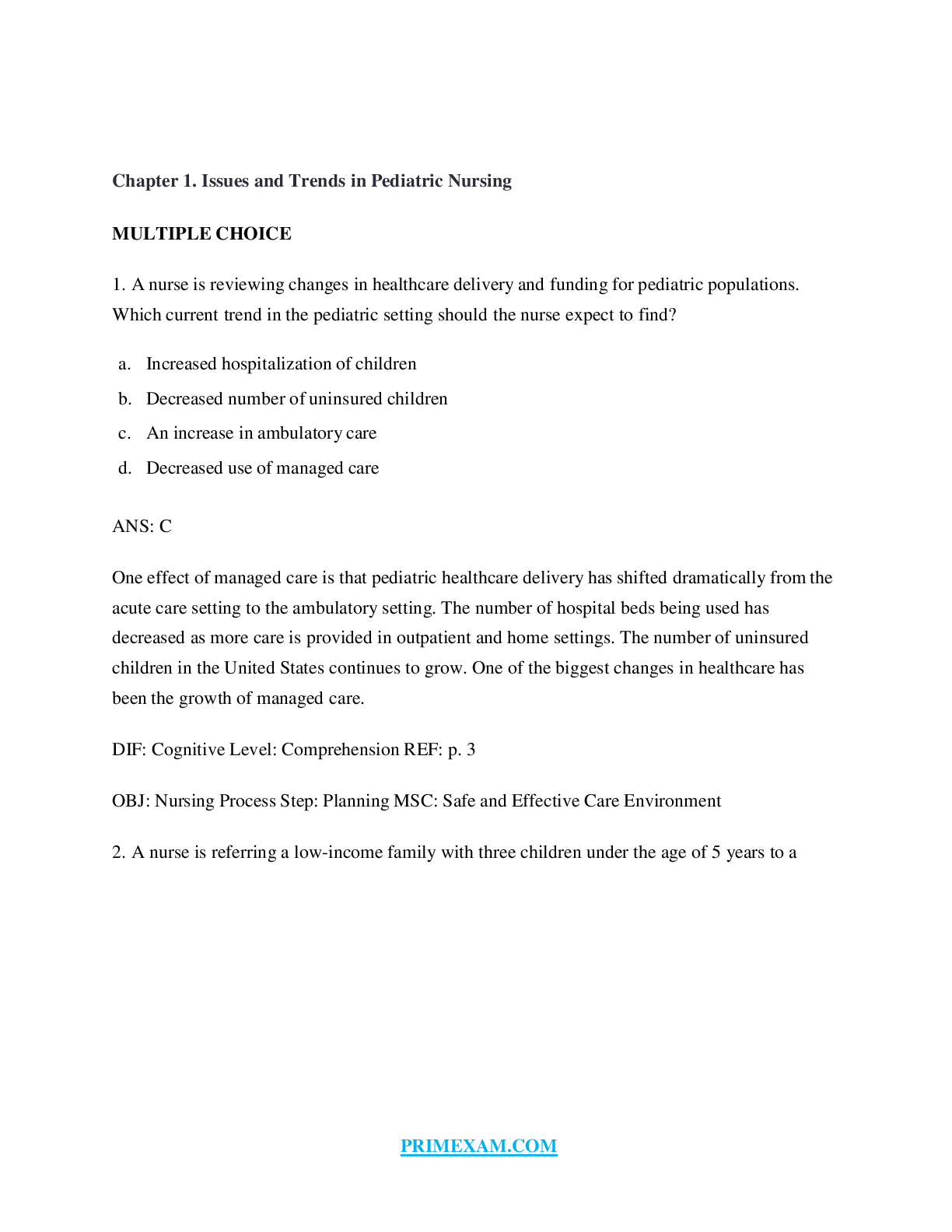
Pediatric Nursing The Critical Components of Nursing Care 2nd Edition Rudd Test Bank
Pediatric Nursing The Critical Components of Nursing Care 2nd Edition Rudd Test BankPediatric Nursing The Critical Components of Nursing Care 2nd Edition Rudd Test BankPediatric Nursing The Critical C...
By NurseGrade , Uploaded: Feb 28, 2024
$22
*NURSING> TEST BANK > Maternal-Newborn Nursing The Critical Components Edition Durham Chapman Test Bank Maternal-Newborn Nursing The Critical Components of Nursing Care 3rd Edition Durham Chapman Test Bank (All)
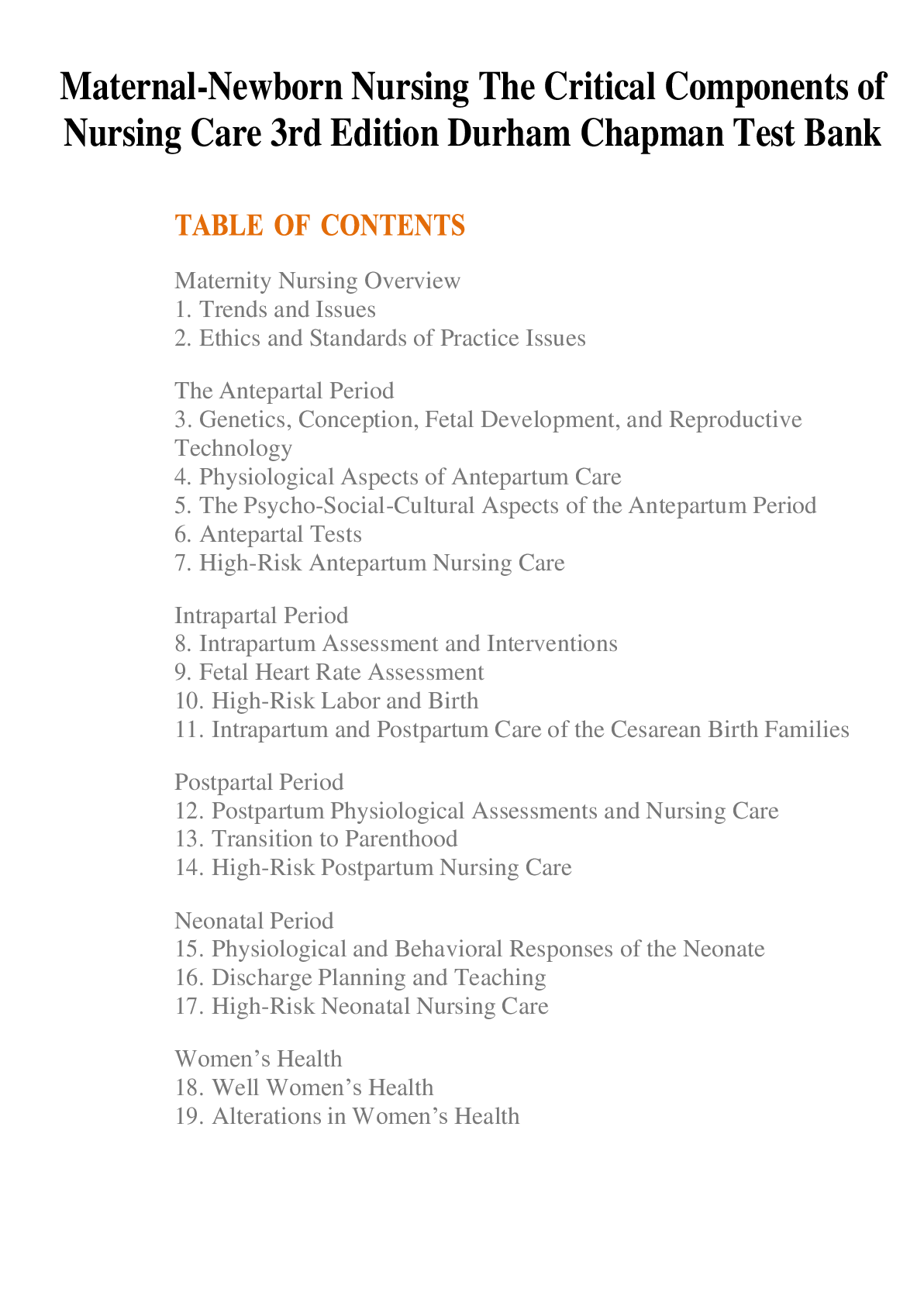
Maternal-Newborn Nursing The Critical Components Edition Durham Chapman Test Bank Maternal-Newborn Nursing The Critical Components of Nursing Care 3rd Edition Durham Chapman Test Bank
Maternal-Newborn Nursing The Critical Components of Nursing Care 3rd Edition Durham Chapman Test BankMaternal-Newborn Nursing The Critical Components of Nursing Care 3rd Edition Durham Chapman Test Ba...
By NurseGrade , Uploaded: Feb 27, 2024
$19
*NURSING> TEST BANK > Pediatric Nursing The Critical Components of Nursing Care 2nd Edition Rudd TEST BANK (All)
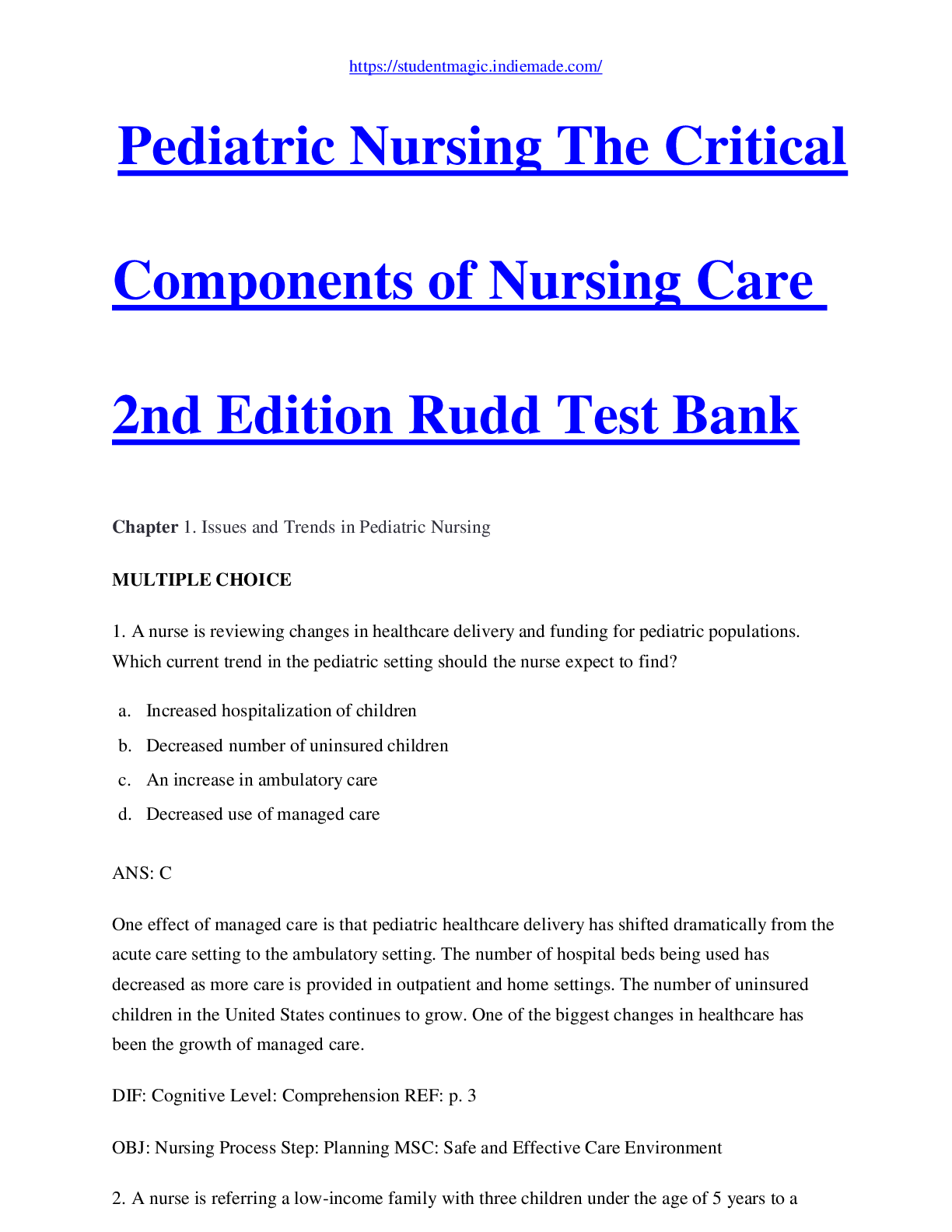
Pediatric Nursing The Critical Components of Nursing Care 2nd Edition Rudd TEST BANK
Pediatric Nursing The Critical Components of Nursing Care 2nd Edition Rudd Test BankPediatric Nursing The Critical Components of Nursing Care 2nd Edition Rudd Test BankPediatric Nursing The Critical C...
By NurseGrade , Uploaded: Jul 24, 2021
$21
*NURSING> TEST BANK > Test Bank Pediatric Nursing The Critical Components of Nursing Care 3rd Edition (1) (All)
.png)
Test Bank Pediatric Nursing The Critical Components of Nursing Care 3rd Edition (1)
Test Bank Pediatric Nursing The Critical Components of Nursing Care 3rd Edition (1) Test Bank Pediatric Nursing The Critical Components of Nursing Care 3rd Edition (1)Test Bank Pediatric Nursing The C...
By QUIZBANK , Uploaded: Apr 30, 2022
$17
*NURSING> TEST BANK > Test Bank For Pediatric Nursing The Critical Components of Nursing Care 2nd Edition Rudd (All)
.png)
Test Bank For Pediatric Nursing The Critical Components of Nursing Care 2nd Edition Rudd
Test Bank For Pediatric Nursing The Critical Components of Nursing Care 2nd Edition Rudd
By browseAgrades , Uploaded: Feb 01, 2022
$20.5
*NURSING> TEST BANK > Davis Advantage for Pediatric Nursing Critical Components of Nursing Care, 3e Kathryn Rudd, Diane Kocisko (Test Bank) (All)
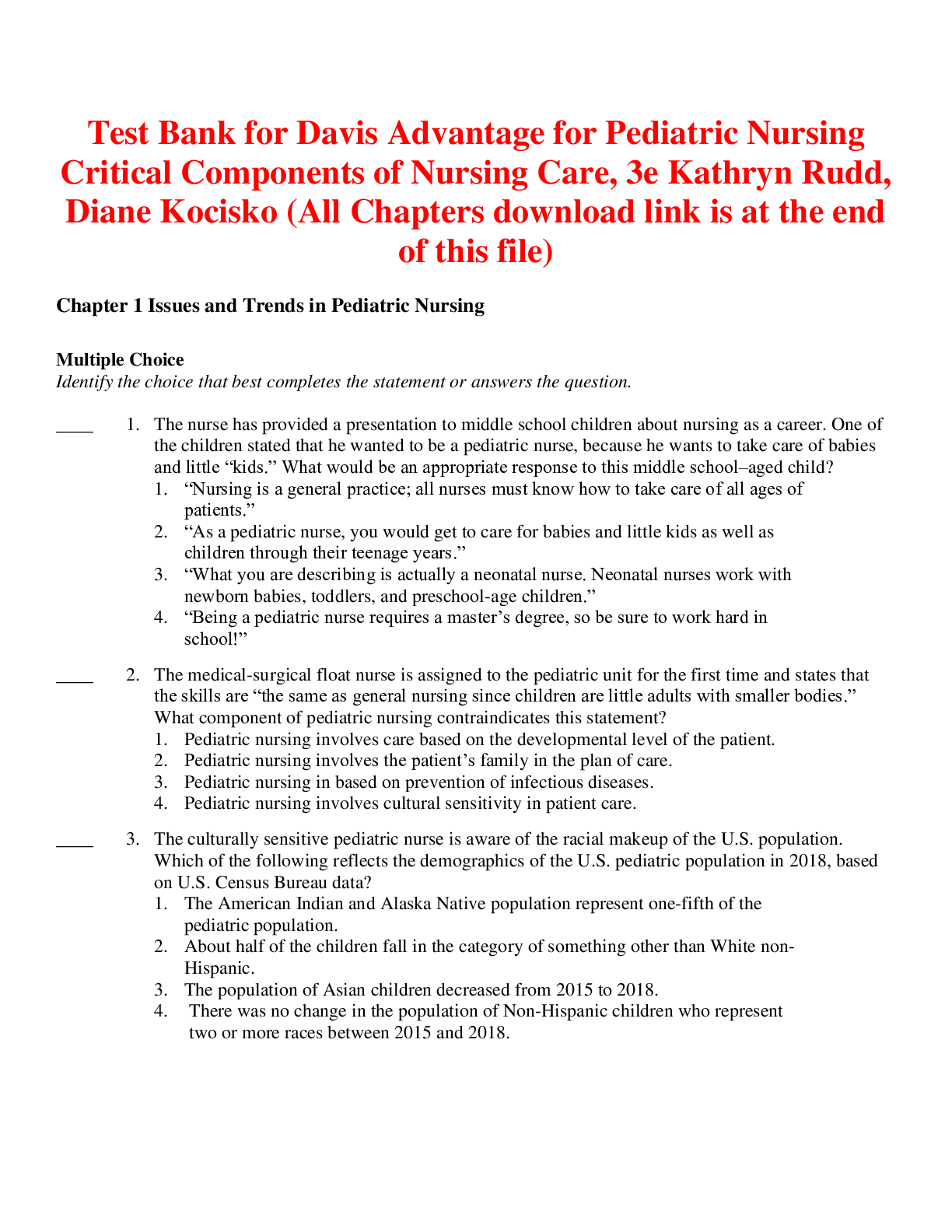
Davis Advantage for Pediatric Nursing Critical Components of Nursing Care, 3e Kathryn Rudd, Diane Kocisko (Test Bank)
Davis Advantage for Pediatric Nursing combines an easy-to-read textbook with an innovative online program to create an immersive learning experience for students and an integrated solution for instruc...
By eBookSmTb , Uploaded: Jan 16, 2023
$25
*NURSING> TEST BANK > Maternal-Newborn Nursing The Critical Components of Nursing Care 3rd Edition Durham Chapman Test Bank (All)

Maternal-Newborn Nursing The Critical Components of Nursing Care 3rd Edition Durham Chapman Test Bank
Chapter 1: Trends and Issues MULTIPLE CHOICE 1. The nurse is caring for a patient who is in labor with her first child. The patient’s mother is present for support and notes that things have change...
By Gradexam , Uploaded: Jul 23, 2021
$22
*NURSING> TEST BANK > Test Bank for Pediatric Nursing The Critical Components of Nursing Care 2nd Edition by Rudd (All)

Test Bank for Pediatric Nursing The Critical Components of Nursing Care 2nd Edition by Rudd
Pediatric Nursing The Critical Components of Nursing Care 2nd Edition Rudd Test Bank ALL CHAPTERSPediatric Nursing The Critical Components of Nursing Care 2nd Edition Rudd Test Bank ALL CHAPTERSPediat...
By Gradexam , Uploaded: Jul 24, 2021
$22
Document information
Connected school, study & course
About the document
Uploaded On
Jul 28, 2021
Number of pages
292
Written in
Additional information
This document has been written for:
Uploaded
Jul 28, 2021
Downloads
2
Views
138






